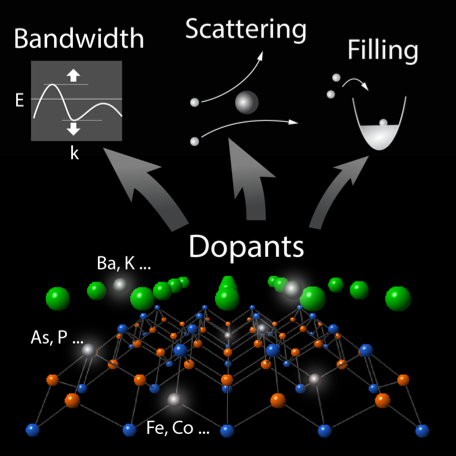Extraordinary doping effects on quasiparticle scattering and bandwidth in iron-based superconductors
Chemical substitution plays an important role in tuning properties and inducing emergent phenomena in correlated materials. The high-temperature superconductivity in the iron-based superconductors could be obtained by chemical substituting. Like cuprates, the undoped compounds of iron-based superconductors are intimately related to magnetic orders. With carrier doping, the magnetic order is suppressed and superconductivity emerges. Phenomenologically, the superconducting transition temperature (TC) is very sensitive to the doping level and the superconducting region exhibits a dome-like shape in the phase diagram. Comprehensively understanding the role of dopants on the electronic structure and further figuring out their effects on the superconductivity are of great importance for uncovering the mechanism of iron-based superconductivity.
We have systematically studied the effects of chemical substitution in various iron-based superconductors. In addition to the control of Fermi surface topology with heterovalent doping, we found two more extraordinary effects: 1. the site and band dependencies of quasiparticle scattering; and more importantly 2. the ubiquitous and significant bandwidth-control by both isovalent and heterovalent dopants in the iron-anion layer. We found that such a bandwidth-control could be achieved by either applying the chemical pressure or doping electrons, but not by doping holes. More intriguingly, when the bandwidth is increased beyond a common range, the superconductivity would disappear. On the other hand, after examining a large variety of Fermi surfaces of iron-based superconductors, we suggest that the Fermi surface topology should play a secondary role on the superconductivity. Our results complete the microscopic picture of the electronic effects of dopants, which facilitates a comprehensive understanding of the diversified phase diagrams of various iron-based superconductors. In addition, it suggests that higher TC can be achieved by introducing moderate electronic correlations while minimizing impurity in the iron-anion layer.
Reference: Z. R. Ye, Y. Zhang, F. Chen, M. Xu, J. Jiang, X. H. Niu, C. H. P. Wen, L. Y. Xing, X. C. Wang, C. Q. Jin, B. P. Xie, and D. L. Feng, Extraordinary doping effects on quasiparticle scattering and bandwidth in iron-based superconductors. Phys. Rev. X. 4, 031041 (2014). Link

